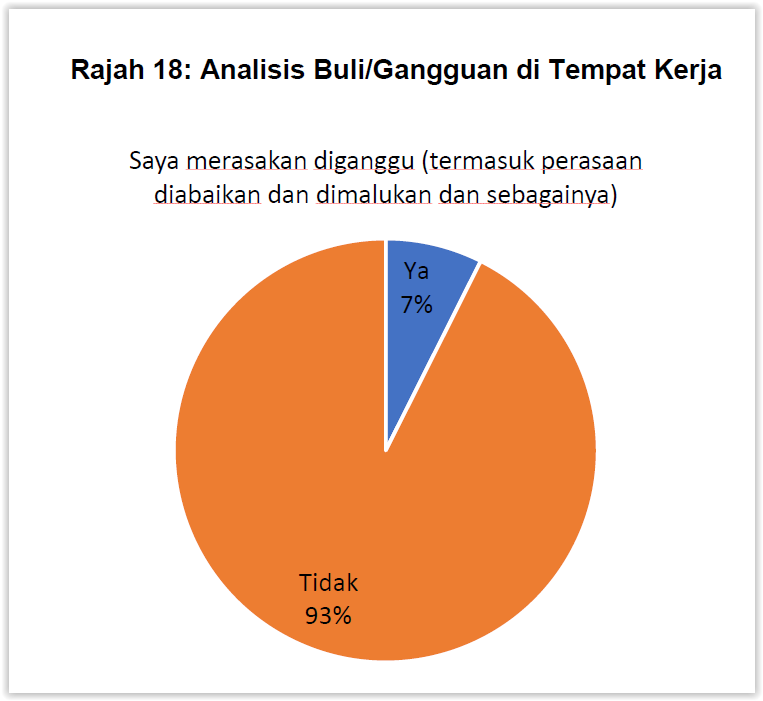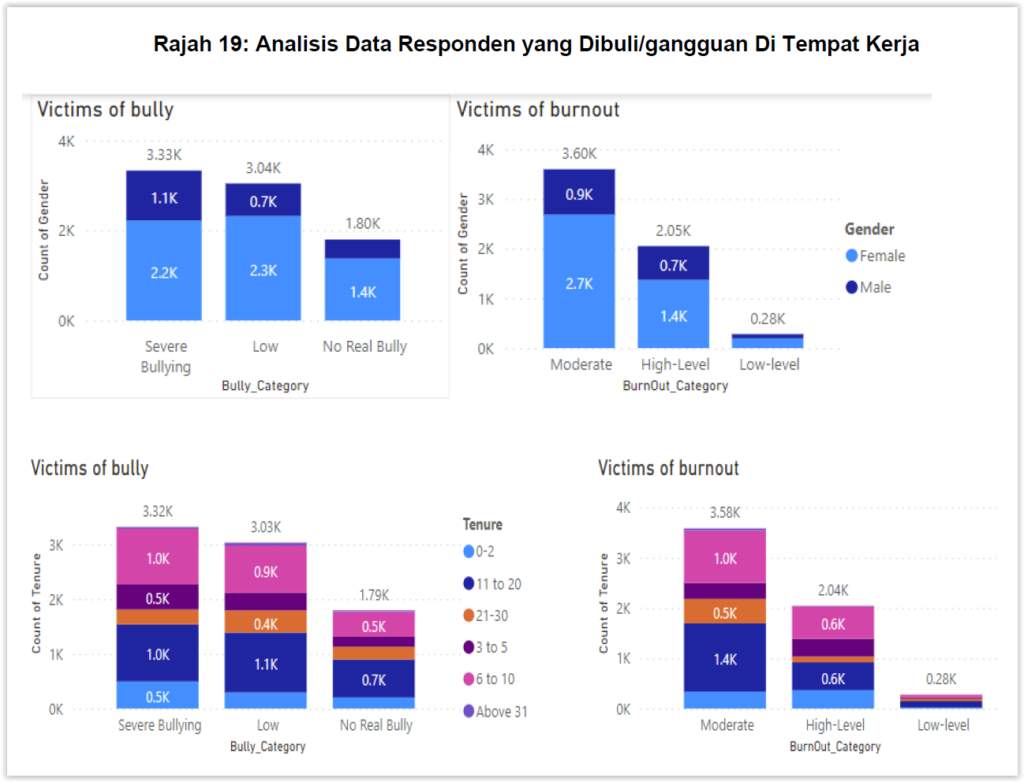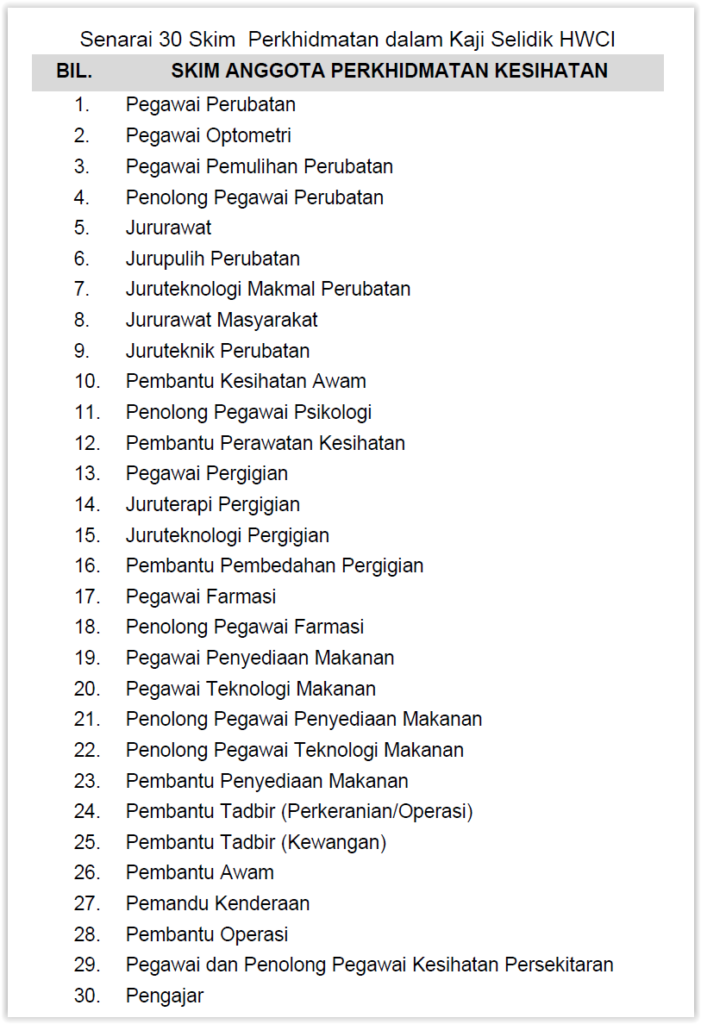KUALA LUMPUR, August 18 – About 23 per cent of supervisors or managers in Ministry of Health (MOH) facilities admitted that they engage in workplace bullying, according to a survey by the Healthcare Work Culture Improvement Task Force (HWCITF).
The findings of the independent committee’s survey across MOH’s entire workforce, with medical practitioners comprising less than a quarter of participants, showed that of the 20,633 respondents from the management or supervisory level, 4,692 admitted to acts of bullying in their workplace.
Twenty per cent, or 924 of the 4,692 self-confessed workplace bullies, said they engaged in “severe” bullying, while the majority at 3,768 respondents admitted to bullying their coworkers or subordinates at a “low” level.
HWCITF’s report released yesterday did not define “severe” or “low” bullying.
Workplace bullies in MOH described their acts of bullying as restricting access to information that affects another person’s performance and instructing people to perform duties beyond their competence.
Perak: Highest Numbers Of Both Workplace Bullies And Overall Survey Respondents

Perak emerged as the state with the highest number of workplace bullies in MOH with 561 respondents who admitted to bullying, followed by Selangor (514), Pahang (487), Johor (461), and Sabah (422).
In terms of severe bullying, however, Pahang recorded the highest number of self-confessed workplace bullies at 102 respondents, followed by Perak (98), Selangor (96), Johor (82), and Sabah and Sarawak at 79 each.
HWCITF’s report did not state which departments or the type of health care facility that these workplace bullies work in.
The states with the highest number of self-confessed workplace bullies correspond to the states with the highest number of survey respondents.
In HWCITF’s online survey across all workforce levels and departments in MOH conducted from May 27 to June 10 this year, the top five states with the highest number of respondents were Perak, Selangor, Sabah, Pahang, and Johor.
Hence, it is possible that workplace bullies from other states may be under-represented due to them not participating in the survey, as HWCITF’s report failed to state the prevalence of workplace bullies by state.
Housemen, Junior MOs Only 11% Of Survey Respondents

In HWCITF’s online survey of 110,411 respondents across all levels of MOH’s workforce throughout 30 service schemes, house officers and junior medical officers only comprised 11 per cent of respondents, or 12,517 staff in Grades 41 to 44, according to the graphic in HWCITF’s report.
Medical officers and specialists in Grades 47 to 56 comprised another 11 per cent, or 12,163 staff, according to the graphic.
Together, doctors from grades 41 to 56 make up less than a quarter (22 per cent) of respondents, or 24,680 people.
Respondents from the medical programme, where trainee doctors are placed in, only comprised slightly over a third at 35 per cent or 38,510 of total respondents. The public health programme made up 36 per cent of respondents.
About 47 per cent (52,349) respondents are working in hospitals, followed by public health clinics at 23 per cent (25,457).
Women: Majority Of Workplace Bullies, 75% Of Survey Respondents

Women comprised the majority of workplace bullies in MOH, but HWCITF did not state the percentage or specific figures.
However, 75 per cent of survey respondents are women. Hence, it is possible that male bullies are under-represented as they may not have taken part in the poll; HWCITF’s report omitted the prevalence of workplace bullies by gender.
The majority of workplace bullies from the management or supervisory level have 11 to 30 years of service, but again, HWCITF’s report did not provide percentages or specific figures.
Bullying Victims: Housemen, Medical Officers, Specialists In Hospitals And Clinics

HWCITF’s report stated that 8,172, or 7.4 per cent of 110,411 total respondents, reported feeling bullied or harassed in the workplace.
Respondents who reported being bullied are house officers and junior medical officers in Grades 41 to 44, as well as medical officers and specialists in Grades 47 to 56.
These bullying victims are single and work in public hospitals and public health clinics run by MOH in the medical and public health sectors.
However, HWCITF’s report failed to provide percentages or specific figures of housemen or junior medical officers among bullying victims.
HWCITF’s report also omitted the prevalence of bullying among the minority (11 per cent) of respondents who are house officers or junior medical officers.
The report noted that although 8,172 respondents (7 per cent) reported suffering workplace bullying or harassment, 6,375 of them reported “low-level bullying” to “occurrence of bullying or harassment”, while 1,797 respondents “felt they were bullied but the total score of respondents falls under the ‘no bullying’ category”.
It is unclear what HWCITF means by this.
Bullying victims described acts of bullying as being instructed to perform work beyond their competence or expertise, excessive monitoring of their work by their supervisor, and their opinions being ignored.
Personal bullying or harassment was described as repeatedly bringing up their mistakes, ignoring them or when they face a threatening situation, and when coworkers spread rumours about them.
Physical bullying or harassment was described as facing a threatening situation, an invasion of personal space, pushed and blocked from walking their path, threatened with getting roughed up, and being a target of spontaneous scolding.

About 3,300 of bullying victims reported “severe” bullying, some 40 per cent of 8,172 respondents who complained about bullying, while 3,040 respondents (37 per cent) reported “low” bullying, and the remaining 1,800 said “no real bully”. HWCITF’s report did not provide specific figures for these, merely rounding them up.
Among the some 3,300 victims of severe bullying, 1,000 have six to 10 years of service, while another 1,000 have 11 to 20 years of service.
Only a minority of victims of severe bullying are in service for less than two years (500 respondents) and three to five years (500 respondents). Generally, housemen are in service for less than two years and junior medical officers for three to five years, unless they get extended. Roughly the same proportions were found among victims of low bullying.
HWCITF’s report did not name the facilities or states where these bullying victims work.
Major Discrepancy Between 8,000 Bullying Victims Reported And 30,000 Reporting At Least One Form Of Bullying

HWCITF’s report appeared to have a huge discrepancy in reporting workplace bullying in MOH.
Although an earlier section of the report stated that only 8,172 respondents reported “feeling bullied or harassed in the workplace”, a subsequent graphic on the different forms of workplace bullying or harassment showed a maximum number of nearly 30,000 respondents who said they experienced at least one type of bullying.
The graphic illustrated the number of respondents who experienced different types of workplace bullying or harassment – intimidation, isolation, vilification, inflammatory language, harassment, unfair compensation, unfair working hours, and unfair workload – broken down by frequency (now and then, monthly, weekly, and daily).
HWCITF’s report did not state the n value in the graphic, or sample size. Neither were specific figures or percentages provided for the different frequencies of workplace bullying reported.
Assuming that respondents are free to select more than one type of workplace bullying experienced, the maximum number of respondents who experienced at least one type of bullying is nearly 30,000 – for the “unfair workload” category.
That figure is nearly four times higher than the 8,000 over respondents who were stated to have experienced workplace bullying or harassment.
The written text of the report states that 13,086 respondents faced unfair workloads either on a monthly (7,058), weekly (4,469), or daily (1,559) basis. The number of respondents who suffered this now and then was not included.
More than 20,000 respondents said they suffered harassment, unfair compensation, unfair working hours, and/ or unfair workload – all higher than the purported 8,172 respondents who reported experiencing workplace bullying or harassment.
Survey Claims To Target Doctors, But 77% Of Respondents Aren’t Medical Practitioners

Although HWCITF’s report claimed that questions in its survey were designed “specifically for medical practitioners”, the task force sought at least 227,736 respondents from across 30 service schemes in MOH’s entire workforce totalling 246,278 staffers throughout MOH health care facilities, institutes, state health departments, and MOH’s headquarters.
The total of 110,411 respondents translates to a 48 per cent response rate.
These 30 service schemes comprise not just medical practitioners, but also other health care professionals like nurses, dentists, pharmacists, and non-health care workers like drivers and admin assistants that were included in HWCITF’s poll.
Nearly half, or 47 per cent, of survey respondents are in grades 29 to 38. Respondents in grades 11 to 26 comprise another 30 per cent.
Medical practitioners are at least grade 41 and above. Yet, respondents of grade 41 and above, including less than 300 high-ranking JUSA officers, only make up 23 per cent of the sample size at 24,977 people.
HWCITF’s 23-page online survey was conducted via Google Forms that required participants to sign in with their Google account to limit respondents to one response each. HWCITF’s report stressed that anonymity of respondents, however, was preserved by removing their email addresses before the data was processed by HWCITF’s data analysis team.
HWCITF concluded that workplace bullying was not happening across all MOH health care facilities and that such incidents were not confined to house officers.
However, the nine-member task force, chaired by former Ministry of Science, Technology and Innovation secretary-general Prof Siti Hamisah Tapsir, failed to publicly identify the problematic health care facilities with rife workplace bullying or to state whether the majority of junior doctors polled reported suffering bullying in the workplace.
HWCITF’s three-month-long investigation – which included engagement sessions with representatives of house officers, doctors’ groups, and medical schools, besides its survey – was triggered by the death of a Penang Hospital houseman last April that led to subsequent anecdotal reports of workplace bullying and sexual harassment of junior doctors. The committee concluded it had no firm evidence to link the Penang Hospital house officer’s death to workplace bullying.








